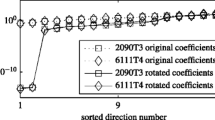Summary
The MATMOD-4V-DISTORTION model has been derived [1] with the intent of improving the MATMOD-4V model by adding the capability to predict “distortions” of small strain offset yield surfaces. This model is compared against a variety of experimental data to verify its behavior. Model simulations are compared with experimental data for proportional and nonproportional prestress histories and the effect of yield definition is also investigated. Finally, the same model which predicts a flattening of the yield surface in\(\sigma - \sqrt 3 {\mathbf{ }}\tau \) space is used to predict a rotation of the yield surface in σ1-σ2 coordinates.
Similar content being viewed by others
References
Helling, D. E., Miller, A. K.: The incorporation of yield surface distortion into a unified constitutive model, part 1: Equation development. Acta Mechanica69, 9–23 (1987).
Helling, D. E., Miller, A. K., Stout, M. G.: An experimental investigation of the yield loci of 1100-O aluminum, 70∶30 brass, and an overaged 2024 aluminum alloy after various prestrains. J. Engg. Mater. Tech., Trans. ASME108, 313–320 (1986).
Helling, D. E.: The incorporation of yield surface distortion into a unified constitutive model. Ph. D. dissertation, Stanford University 1986.
Lowe, T. C., Miller, A. K.: Improved constitutive equations for modeling strain softening — Part II: Predictions for aluminum. J. Engg. Mater. Tech., Trans. ASME106, 343–348 (1984).
Lowe, T. C.: New concepts in modeling strain softening. Ph. D. dissertation, Stanford University 1983.
Shiratori, E., Ikegami, K., Yoshida, F.: Analysis of stress-strain relations by use of an anisotropic hardening plastic potential. J. Mech. Phys. Solids27, 213–229 (1979).
Hecker, S. S.: Influence of deformation history on the yield locus and stress-strain behavior of aluminum and copper. Metallurgical Trans.4, 985–989 (1971).
Phillips, A., Kasper, R.: On the foundations of thermoplasticity — an experimental investigation. J. Applied Mech., Trans. ASME40, 891–896 (1973).
Moreton, D. N., Moffat, D. G., Parkinson, D. B.: The yield surface behavior of pressure vessel steels. J. Strain Anal.16, 127–136 (1981).
Author information
Authors and Affiliations
Additional information
With 9 Figures
Rights and permissions
About this article
Cite this article
Helling, D.E., Miller, A.K. The incorporation of yield surface distortion into a unified constitutive model, part 2: Predictive capabilities. Acta Mechanica 72, 39–53 (1988). https://doi.org/10.1007/BF01176542
Received:
Issue Date:
DOI: https://doi.org/10.1007/BF01176542



